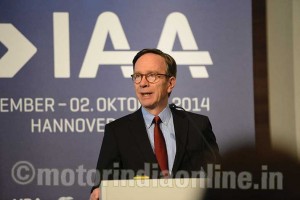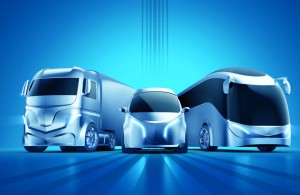“Economic developments in important commercial vehicle markets provide a boost for the 65th IAA Commercial Vehicles which opens in Hannover in September. Western Europe has seen three per cent growth in its commercial market this year, while the US market has recorded double-digit growth and China four per cent growth.

This was disclosed by Mr. Matthias Wissmann, President of the German Association of the Automotive Industry (VDA), while addressing an international group of around 150 journalists at the International Press Workshop on commercial vehicles in Frankfurt am Main.
The press workshop is traditionally organised by VDA in the run-up to the IAA Commercial Vehicles. High-ranking representatives of the commercial vehicle industry from Germany and abroad provide information for the media about innovations and developments in the world of commercial vehicles at Europe’s most important workshop in the field.
Mr. Wissmann stated that in the period up to April the Western European market for heavy commercial vehicles of over 6 t in particular had grown by three per cent, i.e., more than was expected based on pre-buy effects of the Euro VI standard. Euro VI came into force at the beginning of 2014, triggering a significant increase in purchases of Euro V vehicles, primarily in the fourth quarter of 2013.
“In Germany, too, this year’s trend has been very welcome: By the end of May 2014, over 34,000 heavy commercial vehicles (over 6 t) were newly registered, which is a 12 per cent year-on-year rise,” Mr. Wissmann said. This was another visible “Euro V impact.”
He added that the speed of growth would probably ease off later in the year owing to the underlying effect. New registrations of light commercial vehicles (up to 6 t) in Germany totalled 88,000 (+7 per cent) over the first five months of this year. Business in trailers and bodies had been especially dynamic, Mr. Wissmann continued, and stressed that new registrations in this segment were up 14 per cent in the period to May.
The healthy situation was also indicated by the proportion of the workforce involved: one quarter of the more than 760,000 employees in the domestic automotive industry work on commercial vehicles. That is around 190,000 employees.
The VDA President was critical of the plans for the truck toll. For example, the new expert opinion on charging for national roads again indicates much higher costs per truck kilometre. “If this is implemented as it stands, the tariffs for national roads will be more than double those for motorways. That would have considerable structural-policy impacts – principally if, as planned, tolls are introduced on all national roads from 2018. It would harm parts of the country that are structurally underdeveloped. We therefore propose that initially the motorway toll should continue to apply to four-lane national roads. By 2018 the overall effects of the toll for national roads could be analysed precisely.”
 He observed that “the main challenge” for commercial vehicle manufacturers was to achieve further reductions in fuel consumption, and therefore in CO2 emissions. “However, heavy-duty commercial vehicles cannot be compared with passenger cars or vans, for which the EU already has CO2 regulations. The CV business is like a football team. It has not only defenders, but also midfielders and strikers. The variety of models among heavy trucks is so large that there cannot be any ‘standard CO2 value’. The range goes from tipper trucks on construction sites to delivery vehicles and all the way to long-distance haulage trucks. Then there are also urban buses and coaches. Many vehicles are tailor-made for the customers. Very many factors affect consumption – trucks vary in size, weight, usage, mileage, operating conditions, and especially their loads.”
He observed that “the main challenge” for commercial vehicle manufacturers was to achieve further reductions in fuel consumption, and therefore in CO2 emissions. “However, heavy-duty commercial vehicles cannot be compared with passenger cars or vans, for which the EU already has CO2 regulations. The CV business is like a football team. It has not only defenders, but also midfielders and strikers. The variety of models among heavy trucks is so large that there cannot be any ‘standard CO2 value’. The range goes from tipper trucks on construction sites to delivery vehicles and all the way to long-distance haulage trucks. Then there are also urban buses and coaches. Many vehicles are tailor-made for the customers. Very many factors affect consumption – trucks vary in size, weight, usage, mileage, operating conditions, and especially their loads.”
“It is the market that for many years has ensured continuous reduction in fuel consumption by heavy commercial vehicles, without the help of a CO2 regulation. The forwarders calculate very carefully, right down to the last cent, and therefore demand ever greater efficiency from their trucks. Trucks already exist that consume only one litre of diesel for each tonne of goods transported over 100 km when operating at high capacity utilisation in long-distance transport,” Mr. Wissmann emphasised.
He spoke in favour of greater flexibility in vehicle dimensions, better aerodynamics and additional vehicle space for alternative drive train. “These are also ways by which we can bring down CO2 emissions.”
One important tool for improving efficiency and action on climate in road freight traffic is the long truck, Mr. Wissmann said, adding “the field trial with long trucks already shows how comparatively simple changes can increase the capacity of road freight traffic, and this reduces both mileages and CO2 output.”
The field trial now has 79 vehicles plying on pre-determined routes. Experience gained so far indicates that the long trucks live up to expectations: fewer journeys, lower fuel consumption and therefore also lower CO2 emissions. In addition, long trucks could “participate in daily traffic without any problem,” and to date no incidents have been recorded.
“Now that the Federal Constitutional Court has clarified the disputed legal questions, I am appealing to the German States not yet participating: become active in the field trial! It tackles the important issue of whether we can exploit the advantages of long trucks for viable future road freight traffic and, if so, how. This is relevant to all regions in Germany, and also to use of these trucks in Europe,” he underlined.
The deregulation of the long-distance bus market was a “real success story,” the VDA president underscored. “Long-distance coaches have become established within only a short time as an important additional form of mobility for longer routes. The number of coach services has trebled to around 250 in only 15 months.”
Estimates put the number of coach passengers in the first year of market deregulation at around 8.3 million, and there is more potential. Many coach operators had their vehicles permanently on the road with annual mileages of around 300,000 km. After only a few years it is therefore time to renew them.
“Some providers have already announced that in 2014 they are going to seriously expand their bus fleets and the network,” Mr. Wissmann said and explained that it is now necessary to rapidly establish and expand bus terminals and parking facilities, with action needed most of all from municipalities.
“Coaches are also leading the field in climate efficiency and safety,” he underlined. A full coach consumes only about 0.5 litres of fuel per passenger per 100 km. Furthermore, numerous driver assistance and safety systems in modern buses ensure the highest level of safety for the occupants.
The VDA President was unequivocal in his rejection of a bus toll: “Only last October did the transport ministers’ conference dismiss the idea of a bus toll, to avoid extra burdens for small and medium-sized bus operators.”
Turning to the world’s most important trade fair for transport, mobility and logistics, Mr. Wissmann observed: “In three months the 65th IAA Commercial Vehicles will kick off in Hannover. Preparations are on at full speed. We already have a large number of registrations, so all the major manufacturers and very many suppliers will be present when the IAA opens its doors in Hannover on September 25. Of course, attention will focus on the many world premieres, for which the IAA slogan is absolutely tailor-made: ‘Driving the Future’.”
The exhibitrs range from vans to medium-sized trucks and all the way to heavy-duty trucks. It also covers buses, manufacturers of trailers and bodies, and the many innovative suppliers and service providers. “Efficiency, flexibility and connectivity – these are the catchwords embodying the innovations we can expect at IAA,” Wissmann underlined.
IAA is also a major congress with around 30 specialist events, including the China Day, the India Day, a CO2 event and the symposia on long-distance coaches, load securing and transportation of hazardous goods. And, of course, visitors can also look forward to a large number of exciting test drives.